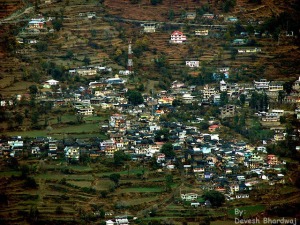In the beautiful state of Himachal Pradesh, there are numerous places that remain unknown and unfrequented. Perhaps therein lies the charm, for they remain pristine unlike Shimla and Manali. Nirmand, a sprawling village to the south of Kullu district is one such place, which is often referred to as ‘the Kashi of the Himalayas’.
Nirmand is a sacrosanct place where Parshuram Rishi is believed to have settled the Brahmins in a bid to eliminate the Kshatriyas, members of the warrior caste from the face of the earth. Not only is the village inhabited predominantly by Brahmins, it is studded with wood and stone temples, big and small. It is replete with myths, legends and folklore clustered around the figure of the irascible sage. The rishi has a temple built in his honor, a large fortress-like structure known as the Parasram kothi, which occupies the pivotal position in the village. All the lanes and streets in the village converge towards it.
HISTORY
This is connected with Parshuram who was told to kill his mother by his father Rishi Jamdagni,but the son was clever enough to extract a boon from his father, by virtue of which he succeeded in reviving his mother. Each one of them has a shrine built in their honor. The kothi has a big storehouse containing invaluable art objects and historical documents-among them a copper place title deed of the seventh century issued by Mahasamanta Samudrasen in favour of the Brahmins of Nirmand and a gold metal plaque of Mujuni Devi in chaste classical style.
TOURISTS ATTRACTIONS
The pilgrimage to this holy site (Parasram kothi) begins from the northeast end of Nirmand. At this entry point are located two temples, one of Chandika Devi, which is the main shrine, and on its side a miniature stone shrine of Shiva dating back to the medieval period. The Chandika temple has neither any elaborate architecture nor any sculptural embellishment, although the wooden doorway to the sanctum is a replica of one seen in the Dakhani Mahadev temple nearby.
The village is well worth a visit for a lover of temples, sculptures and antique sites, also for pilgrims, large numbers of who visit this place all through the year. Most of them are itinerant sadhus, for whom, since the earliest times, a special site-a large compound surrounded by shelters-has been allocated in the center of the village.
From the kothi, walking straight ahead, there is a magnificent flight of broad stone steps leading down the slope to the modern looking hut-shaped temple of Ambica Devi, the most frequented shrine for the pilgrims. Facing the shrine is a pair of lions in obeisance to the goddess. The stone paved way leads to Kurpan Khud, Bashleo Pass and down to Manglaur to meet the Inner Saraj road.
To the southwest of the Ambica temple stands the Shiva Temple in a woeful state of neglect.
Although Nirmand does not boast of much scenic splendor, the area all around and beyond such as Arsu, Bashleo Pass and the villages all along the route are a trekker’s delight. Trekkers can go to Jalori Pass and Banjar, visiting numerous picturesque and interesting villages that have much to offer to the curious traveler.
Nirmand is perched atop the mountain range, standing like a sentinel opposite Dattanagar on the Hindustan-Tibet road. Incidentally, Dattanagar is also a holy site on account of its having been founded by Sage Dattatreya who is venerated in a shrine.
The area is rich in herbs of various kinds and the sight of fruit trees laden with golden apricots, green almonds, plums, cherries, pears and luscious apples are sufficient compensation for the pains taken to visit such far-flung areas.
FAIRS & FESTIVALS
Every 12th year, the famous bhunda ceremony is performed at the kothi. In the earlier times a human used to be it made to slide down the thick rope into the pit of the valley and perish. However this custom has changed a bit now so that the human has been replaced with a goat.Another famous fair is Budhi Diwali which held after one month interval of Diwali every Year.
HOW TO REACH
Located in Outer Saraj, 700 metres above the waters of the Sutlej, Nirmand is approachable by bus from Rampur Bushahr, 95 kilometers from Shimla. Four kilometers short of Rampur, one crosses the bridge spanning the Sutlej River and turns left. After a 19 kilometers long bumpy journey along the road, one ascends up to the village of Nirmand.
WHERE TO STAY
We offer excellent accommodation facilities in and around Nirmand.

